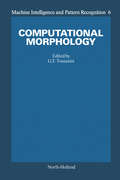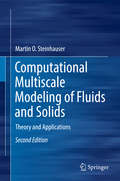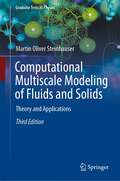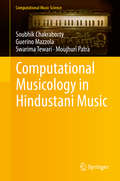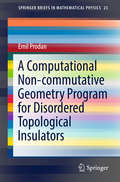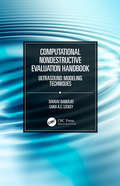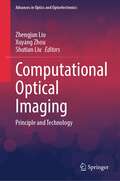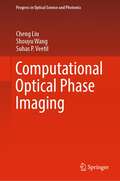- Table View
- List View
Computational Molecular Magnetic Resonance Imaging for Neuro-oncology (Biological and Medical Physics, Biomedical Engineering)
by Michael O. Dada Bamidele O. AwojoyogbeBased on the analytical methods and the computer programs presented in this book, all that may be needed to perform MRI tissue diagnosis is the availability of relaxometric data and simple computer program proficiency. These programs are easy to use, highly interactive and the data processing is fast and unambiguous. Laboratories (with or without sophisticated facilities) can perform computational magnetic resonance diagnosis with only T1 and T2 relaxation data. The results have motivated the use of data to produce data-driven predictions required for machine learning, artificial intelligence (AI) and deep learning for multidisciplinary and interdisciplinary research. Consequently, this book is intended to be very useful for students, scientists, engineers, the medical personnel and researchers who are interested in developing new concepts for deeper appreciation of computational magnetic resonance imaging for medical diagnosis, prognosis, therapy and management of tissue diseases.
Computational Morphologies: Design Rules Between Organic Models and Responsive Architecture
by Michela Rossi Giorgio BurattiThis book represents an invaluable and up-to-date international exchange of research, case studies and best practice to tackle the challenges of digital technology, computer-aided design, 3D modeling, prototyping machines and computational design. With contributions from leading experts in the field of industrial design and cultural heritage, it is split into three parts. The first part explores basic rules of design, design models and shape grammar, including the management of complex forms, and proves that innovative concepts may be derived from organic models using generative design. The second part then investigates responsive design, describing how to manage the changing morphologies of buildings through pre-programmed mechanisms of real-time response and feedback embedded in inhabitable spaces. Lastly, the third part focuses on digital heritage and its capability to increase the interaction and manipulation of object and concepts, ranging from augmented reality to modeling generative tools. The book gathers peer-reviewed papers presented at the eCAADe (Education and Research in Computer-Aided Architectural Design in Europe) Regional International Symposium, held in Milan, Italy, in 2015.
Computational Morphology: A Computational Geometric Approach to the Analysis of Form (Machine Intelligence and Pattern Recognition #Volume 6)
by G. T. ToussaintComputational Geometry is a new discipline of computer science that deals with the design and analysis of algorithms for solving geometric problems. There are many areas of study in different disciplines which, while being of a geometric nature, have as their main component the extraction of a description of the shape or form of the input data. This notion is more imprecise and subjective than pure geometry. Such fields include cluster analysis in statistics, computer vision and pattern recognition, and the measurement of form and form-change in such areas as stereology and developmental biology.This volume is concerned with a new approach to the study of shape and form in these areas. Computational morphology is thus concerned with the treatment of morphology from the computational geometry point of view. This point of view is more formal, elegant, procedure-oriented, and clear than many previous approaches to the problem and often yields algorithms that are easier to program and have lower complexity.
Computational Multiscale Modeling of Fluids and Solids: Theory and Applications
by Martin Oliver SteinhauserThe idea of the book is to provide a comprehensive overview of computational physics methods and techniques, that are used for materials modeling on different length and time scales. Each chapter first provides an overview of the basic physical principles which are the basis for the numerical and mathematical modeling on the respective length-scale. The book includes the micro-scale, the meso-scale and the macro-scale, and the chapters follow this classification. The book explains in detail many tricks of the trade of some of the most important methods and techniques that are used to simulate materials on the perspective levels of spatial and temporal resolution. Case studies are included to further illustrate some methods or theoretical considerations. Example applications for all techniques are provided, some of which are from the author’s own contributions to some of the research areas. The second edition has been expanded by new sections in computational models on meso/macroscopic scales for ocean and atmosphere dynamics. Numerous applications in environmental physics and geophysics had been added.
Computational Multiscale Modeling of Fluids and Solids: Theory and Applications
by Martin Oliver SteinhauserDevastatingly simple, yet hugely effective, the concept of this timely text is to provide a comprehensive overview of computational physics methods and techniques used for materials modeling on different length and time scales. Each chapter first provides an overview of the physical basic principles which are the basis for the numerical and mathematical modeling on the respective length scale. The book includes the micro scale, the meso-scale and the macro scale.
Computational Multiscale Modeling of Fluids and Solids: Theory and Applications (Graduate Texts in Physics)
by Martin Oliver SteinhauserThe expanded 3rd edition of this established textbook offers an updated overview and review of the computational physics techniques used in materials modelling over different length and time scales. It describes in detail the theory and application of some of the most important methods used to simulate materials across the various levels of spatial and temporal resolution. Quantum mechanical methods such as the Hartree-Fock approximation for solving the Schrödinger equation at the smallest spatial resolution are discussed as well as the Molecular Dynamics and Monte-Carlo methods on the micro- and meso-scale up to macroscopic methods used predominantly in the Engineering world such as Finite Elements (FE) or Smoothed Particle Hydrodynamics (SPH). Extensively updated throughout, this new edition includes additional sections on polymer theory, statistical physics and continuum theory, the latter being the basis of FE methods and SPH. Each chapter now first provides an overview of the key topics covered, with a new “key points” section at the end. The book is aimed at beginning or advanced graduate students who want to enter the field of computational science on multi-scales. It provides an in-depth overview of the basic physical, mathematical and numerical principles for modelling solids and fluids on the micro-, meso-, and macro-scale. With a set of exercises, selected solutions and several case studies, it is a suitable book for students in physics, engineering, and materials science, and a practical reference resource for those already using materials modelling and computational methods in their research.
Computational Musicology in Hindustani Music (Computational Music Science)
by Soubhik Chakraborty Guerino Mazzola Swarima Tewari Moujhuri PatraThe book opens with a short introduction to Indian music, in particular classical Hindustani music, followed by a chapter on the role of statistics in computational musicology. The authors then show how to analyze musical structure using Rubato, the music software package for statistical analysis, in particular addressing modeling, melodic similarity and lengths, and entropy analysis; they then show how to analyze musical performance. Finally, they explain how the concept of seminatural composition can help a music composer to obtain the opening line of a raga-based song using Monte Carlo simulation. The book will be of interest to musicians and musicologists, particularly those engaged with Indian music.
Computational Network Analysis with R: Applications in Biology, Medicine and Chemistry (Quantitative and Network Biology (VCH))
by Matthias Dehmer Yongtang Shi Frank Emmert-StreibThis new title in the well-established "Quantitative Network Biology" series includes innovative and existing methods for analyzing network data in such areas as network biology and chemoinformatics. With its easy-to-follow introduction to the theoretical background and application-oriented chapters, the book demonstrates that R is a powerful language for statistically analyzing networks and for solving such large-scale phenomena as network sampling and bootstrapping. Written by editors and authors with an excellent track record in the field, this is the ultimate reference for R in Network Analysis.
Computational Network Analysis with R: Applications in Biology, Medicine and Chemistry (Quantitative and Network Biology (VCH))
by Matthias Dehmer Yongtang Shi Frank Emmert-StreibThis new title in the well-established "Quantitative Network Biology" series includes innovative and existing methods for analyzing network data in such areas as network biology and chemoinformatics. With its easy-to-follow introduction to the theoretical background and application-oriented chapters, the book demonstrates that R is a powerful language for statistically analyzing networks and for solving such large-scale phenomena as network sampling and bootstrapping. Written by editors and authors with an excellent track record in the field, this is the ultimate reference for R in Network Analysis.
Computational Network Theory: Theoretical Foundations and Applications (Quantitative and Network Biology (VCH))
by Matthias Dehmer Frank Emmert-Streib Stefan PicklThis comprehensive introduction to computational network theory as a branch of network theory builds on the understanding that such networks are a tool to derive or verify hypotheses by applying computational techniques to large scale network data.The highly experienced team of editors and high-profile authors from around the world present and explain a number of methods that are representative of computational network theory, derived from graph theory, as well as computational and statistical techniques. With its coherent structure and homogenous style, this reference is equally suitable for courses on computational networks.
Computational Network Theory: Theoretical Foundations and Applications (Quantitative and Network Biology (VCH))
by Matthias Dehmer Frank Emmert-Streib Stefan PicklThis comprehensive introduction to computational network theory as a branch of network theory builds on the understanding that such networks are a tool to derive or verify hypotheses by applying computational techniques to large scale network data.The highly experienced team of editors and high-profile authors from around the world present and explain a number of methods that are representative of computational network theory, derived from graph theory, as well as computational and statistical techniques. With its coherent structure and homogenous style, this reference is equally suitable for courses on computational networks.
Computational Neurology and Psychiatry (Springer Series in Bio-/Neuroinformatics #6)
by Péter Érdi Basabdatta Sen Bhattacharya Amy L. CochranThis book presents the latest research in computational methods for modeling and simulating brain disorders. In particular, it shows how mathematical models can be used to study the relationship between a given disorder and the specific brain structure associated with that disorder. It also describes the emerging field of computational psychiatry, including the study of pathological behavior due to impaired functional connectivity, pathophysiological activity, and/or aberrant decision-making. Further, it discusses the data analysis techniques that will be required to analyze the increasing amount of data being generated about the brain. Lastly, the book offers some tips on the application of computational models in the field of quantitative systems pharmacology. Mainly written for computational scientists eager to discover new application fields for their model, this book also benefits neurologists and psychiatrists wanting to learn about new methods.
Computational Neuroscience (Springer Optimization and Its Applications #38)
by Petros Xanthopoulos Wanpracha Chaovalitwongse Panos M. M. PardalosThis volume includes contributions from diverse disciplines including electrical engineering, biomedical engineering, industrial engineering, and medicine, bridging a vital gap between the mathematical sciences and neuroscience research. Covering a wide range of research topics, this volume demonstrates how various methods from data mining, signal processing, optimization and cutting-edge medical techniques can be used to tackle the most challenging problems in modern neuroscience.
A Computational Non-commutative Geometry Program for Disordered Topological Insulators (SpringerBriefs in Mathematical Physics #23)
by Emil ProdanThis work presents a computational program based on the principles of non-commutative geometry and showcases several applications to topological insulators. Noncommutative geometry has been originally proposed by Jean Bellissard as a theoretical framework for the investigation of homogeneous condensed matter systems. Recently, this approach has been successfully applied to topological insulators, where it facilitated many rigorous results concerning the stability of the topological invariants against disorder.In the first part of the book the notion of a homogeneous material is introduced and the class of disordered crystals defined together with the classification table, which conjectures all topological phases from this class. The manuscript continues with a discussion of electrons’ dynamics in disordered crystals and the theory of topological invariants in the presence of strong disorder is briefly reviewed. It is shown how all this can be captured in the language of noncommutative geometry using the concept of non-commutative Brillouin torus, and a list of known formulas for various physical response functions is presented. In the second part, auxiliary algebras are introduced and a canonical finite-volume approximation of the non-commutative Brillouin torus is developed. Explicit numerical algorithms for computing generic correlation functions are discussed. In the third part upper bounds on the numerical errors are derived and it is proved that the canonical-finite volume approximation converges extremely fast to the thermodynamic limit. Convergence tests and various applications concludes the presentation.The book is intended for graduate students and researchers in numerical and mathematical physics.
Computational Noncommutative Algebra and Applications: Proceedings of the NATO Advanced Study Institute, on Computatoinal Noncommutative Algebra and Applications, Il Ciocco, Italy, 6-19 July 2003 (pdf) (NATO Science Series II: Mathematics, Physics and Chemistry #136)
by Jim Byrnes Gerald OstheimerComputational Nondestructive Evaluation Handbook: Ultrasound Modeling Techniques
by Sourav Banerjee Cara A.C. LeckeyIntroducing computational wave propagation methods developed over 40 years of research, this comprehensive book offers a computational approach to NDE of isotropic, anisotropic, and functionally graded materials. It discusses recent methods to enable enhanced computational efficiency for anisotropic materials. It offers an overview of the need for and uses of NDE simulation. The content provides a basic understanding of ultrasonic wave propagation through continuum mechanics and detailed discussions on the mathematical techniques of six computational methods to simulate NDE experiments. In this book, the pros and cons of each individual method are discussed and guidelines for selecting specific simulation methods for specific NDE scenarios are offered. Covers ultrasonic CNDE fundamentals to provide understanding of NDE simulation methods Offers a catalog of effective CNDE methods to evaluate and compare Provides exercises on real-life NDE problems with mathematical steps Discusses CNDE for common material types, including isotropic, anisotropic, and functionally graded materials Presents readers with practical knowledge on ultrasonic CNDE methods This work is an invaluable resource for researchers, advanced students, and industry professionals across materials, mechanical, civil, and aerospace engineering, and anyone seeking to enhance their understanding of computational approaches for advanced material evaluation methods.
Computational Nondestructive Evaluation Handbook: Ultrasound Modeling Techniques
by Sourav Banerjee Cara A.C. LeckeyIntroducing computational wave propagation methods developed over 40 years of research, this comprehensive book offers a computational approach to NDE of isotropic, anisotropic, and functionally graded materials. It discusses recent methods to enable enhanced computational efficiency for anisotropic materials. It offers an overview of the need for and uses of NDE simulation. The content provides a basic understanding of ultrasonic wave propagation through continuum mechanics and detailed discussions on the mathematical techniques of six computational methods to simulate NDE experiments. In this book, the pros and cons of each individual method are discussed and guidelines for selecting specific simulation methods for specific NDE scenarios are offered. Covers ultrasonic CNDE fundamentals to provide understanding of NDE simulation methods Offers a catalog of effective CNDE methods to evaluate and compare Provides exercises on real-life NDE problems with mathematical steps Discusses CNDE for common material types, including isotropic, anisotropic, and functionally graded materials Presents readers with practical knowledge on ultrasonic CNDE methods This work is an invaluable resource for researchers, advanced students, and industry professionals across materials, mechanical, civil, and aerospace engineering, and anyone seeking to enhance their understanding of computational approaches for advanced material evaluation methods.
Computational Nuclear Physics 1: Nuclear Structure
by K. Langanke Joachim Maruhn S. E. KooninA variety of standard problems in theoretical nuclear-structure physics is addressed by the well-documented computer codes presented in this book. Most of these codes were available up to now only through personal contact. The subject matter ranges from microscopic models (the shell, Skyrme-Hartree-Fock, and cranked Nilsson models) through collective excitations (RPA, IBA, and geometric model) to the relativistic impulse approximation, three-body calculations, variational Monte Carlo methods, and electron scattering. The 5 1/4'' high-density floppy disk that comes with the book contains the FORTRAN codes of the problems that are tackled in each of the ten chapters. In the text, the precise theoretical foundations and motivations of each model or method are discussed together with the numerical methods employed. Instructions for the use of each code, and how to adapt them to local compilers and/or operating systems if necessary, are included.
Computational Nuclear Physics 2: Nuclear Reactions
by K. Langanke J. A. Maruhn S. E. KooninComputation is essential to our modern understanding of nuclear systems. Although simple analytical models might guide our intuition, the complex ity of the nuclear many-body problem and the ever-increasing precision of experimental results require large-scale numerical studies for a quantitative understanding. Despite their importance, many nuclear physics computations remain something of a black art. A practicing nuclear physicist might be familiar with one or another type of computation, but there is no way to systemati cally acquire broad experience. Although computational methods and results are often presented in the literature, it is often difficult to obtain the working codes. More often than not, particular numerical expertise resides in one or a few individuals, who must be contacted informally to generate results; this option becomes unavailable when these individuals leave the field. And while the teaching of modern nuclear physics can benefit enormously from realistic computer simulations, there has been no source for much of the important material. The present volume, the second of two, is an experiment aimed at address ing some of these problems. We have asked recognized experts in various aspects of computational nuclear physics to codify their expertise in indi vidual chapters. Each chapter takes the form of a brief description of the relevant physics (with appropriate references to the literature), followed by a discussion of the numerical methods used and their embodiment in a FOR TRAN code. The chapters also contain sample input and test runs, as well as suggestions for further exploration.
Computational Number Theory (Discrete Mathematics And Its Applications Ser.)
by Abhijit DasDeveloped from the author's popular graduate-level course, Computational Number Theory presents a complete treatment of number-theoretic algorithms. Avoiding advanced algebra, this self-contained text is designed for advanced undergraduate and beginning graduate students in engineering. It is also suitable for researchers new to the field and pract
Computational Optical Imaging: Principle and Technology (Advances in Optics and Optoelectronics)
by Zhengjun Liu Xuyang Zhou Shutian LiuThis book highlights a comprehensive introduction to the principles and calculation methods of computational optical imaging. Integrating optical imaging and computing technology to achieve significant performance improvements, computational optical imaging has become an active research field in optics. It has given rise to the emerging of new concepts such as computational imaging, computational measurement and computational photography. As high-performance image detectors make image measurements discrete and digital, images are mostly recorded in the form of discrete data, almost replacing the continuous medium used for pattern recording. Computational optical imaging technology has become an effective way for people to study microscopic imaging. At present, different imaging systems are composed of continuous optical elements such as lenses and prisms or discrete optical elements such as spatial light modulators or digital micro-mirror devices. The current computing technology has permeated all aspects of imaging systems and gradually promotes the digitization of optical imaging systems. This book summarizes the representative work done in this field and introduces the latest results. Computing technology plays an important bridging role between theories of optics and experimental systems, which inspires more comprehensive and in-depth research. It has the advantages of high repeatability, flexibility, strong computing power and low cost. In this multidisciplinary field, researchers in computer science, optics and information science have joined together to extend its depth and breadth. Targeting cutting-edge issues to be solved in computational optics, this book introduces a variety of methods that involve theoretical innovations and technical breakthroughs in imaging resolution, the field of view, imaging speed, and computing speed. It intends to provide a handy reference and technical support for graduate students, researchers and professionals engaged in the study and practice of computational optical imaging.
Computational Optical Phase Imaging (Progress in Optical Science and Photonics #21)
by Cheng Liu Shouyu Wang Suhas P. VeetilIn this book, computational optical phase imaging techniques are presented along with Matlab codes that allow the reader to run their own simulations and gain a thorough understanding of the current state-of-the-art. The book focuses on modern applications of computational optical phase imaging in engineering measurements and biomedical imaging. Additionally, it discusses the future of computational optical phase imaging, especially in terms of system miniaturization and deep learning-based phase retrieval.
Computational Optimal Control (International Series of Numerical Mathematics #115)
by Roland Bulirsch Dieter KraftResources should be used sparingly both from a point of view of economy and eco logy. Thus in controlling industrial, economical and social processes, optimization is the tool of choice. In this area of applied numerical analysis, the INTERNATIONAL FEDERATION OF AUTOMATIC CONTROL (IFAC) acts as a link between research groups in universities, national research laboratories and industry. For this pur pose, the technical committee Mathematics of Control of IFAC organizes biennial conferences with the objective of bringing together experts to exchange ideas, ex periences and future developments in control applications of optimization. There should be a genuine feedback loop between mathematicians, computer scientists, engineers and software developers. This loop should include the design, application and implementation of algorithms. The contributions of industrial practitioners are especially important. These proceedings contain selected papers from a workshop on CONTROL Ap PLICATIONS OF OPTIMIZATION, which took place at the Fachhochschule Miinchen in September 1992. The workshop was the ninth in a series of very successful bien nial meetings, starting with the Joint Automatic Control Conference in Denver in 1978 and followed by conferences in London, Oberpfaffenhofen, San Francisco, Ca pri, Tbilisi and Paris. The workshop was attended by ninety researchers from four continents. This volume represents the state of the art in the field, with emphasis on progress made since the publication of the proceedings of the Capri meeting, edited by G. di Pillo under the title 'Control Applications of Optimization and Nonlinear Programming'.
Computational Optimization: Success in Practice (Textbooks in Mathematics)
by Vladislav BukshtynovThis textbook offers a guided tutorial that reviews the theoretical fundamentals while going through the practical examples used for constructing the computational frame, applied to various real-life models. Computational Optimization: Success in Practice will lead the readers through the entire process. They will start with the simple calculus examples of fitting data and basics of optimal control methods and end up constructing a multi-component framework for running PDE-constrained optimization. This framework will be assembled piece by piece; the readers may apply this process at the levels of complexity matching their current projects or research needs. By connecting examples with the theory and discussing the proper "communication" between them, the readers will learn the process of creating a "big house." Moreover, they can use the framework exemplified in the book as the template for their research or course problems – they will know how to change the single "bricks" or add extra "floors" on top of that. This book is for students, faculty, and researchers. Features The main optimization framework builds through the course exercises and centers on MATLAB®. All other scripts to implement computations for solving optimization problems with various models use only open-source software, e.g., FreeFEM. All computational steps are platform-independent; readers may freely use Windows, macOS, or Linux systems. All scripts illustrating every step in building the optimization framework will be available to the readers online. Each chapter contains problems based on the examples provided in the text and associated scripts. The readers will not need to create the scripts from scratch, but rather modify the codes provided as a supplement to the book. This book will prove valuable to graduate students of math, computer science, engineering, and all who explore optimization techniques at different levels for educational or research purposes. It will benefit many professionals in academic and industry-related research: professors, researchers, postdoctoral fellows, and the personnel of R&D departments.
Computational Optimization: Success in Practice (Textbooks in Mathematics)
by Vladislav BukshtynovThis textbook offers a guided tutorial that reviews the theoretical fundamentals while going through the practical examples used for constructing the computational frame, applied to various real-life models. Computational Optimization: Success in Practice will lead the readers through the entire process. They will start with the simple calculus examples of fitting data and basics of optimal control methods and end up constructing a multi-component framework for running PDE-constrained optimization. This framework will be assembled piece by piece; the readers may apply this process at the levels of complexity matching their current projects or research needs. By connecting examples with the theory and discussing the proper "communication" between them, the readers will learn the process of creating a "big house." Moreover, they can use the framework exemplified in the book as the template for their research or course problems – they will know how to change the single "bricks" or add extra "floors" on top of that. This book is for students, faculty, and researchers. Features The main optimization framework builds through the course exercises and centers on MATLAB®. All other scripts to implement computations for solving optimization problems with various models use only open-source software, e.g., FreeFEM. All computational steps are platform-independent; readers may freely use Windows, macOS, or Linux systems. All scripts illustrating every step in building the optimization framework will be available to the readers online. Each chapter contains problems based on the examples provided in the text and associated scripts. The readers will not need to create the scripts from scratch, but rather modify the codes provided as a supplement to the book. This book will prove valuable to graduate students of math, computer science, engineering, and all who explore optimization techniques at different levels for educational or research purposes. It will benefit many professionals in academic and industry-related research: professors, researchers, postdoctoral fellows, and the personnel of R&D departments.


